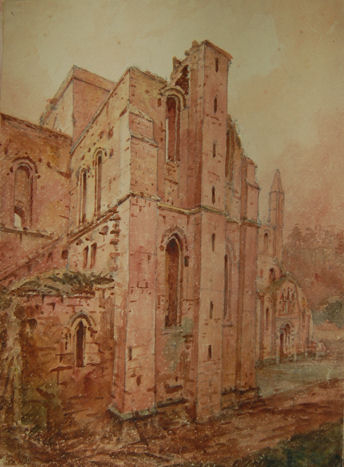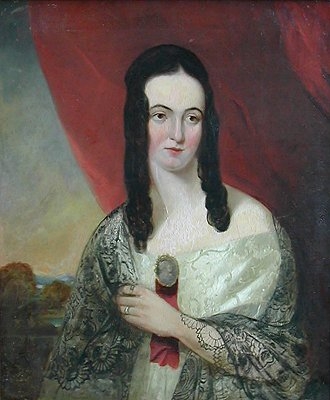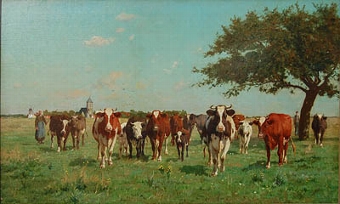It was founded by William Bertram, Baron of Mitford, in the reign of Henry I as an Augustinian priory. The exact date is not known but cannot have been later than 1135 as Henry died that year. About 1180 or so, Brinkburn became an independent house, and the building of the monastic church was commenced. Although the Priory acquired lands in Northumberland and Durham over the years it was never particularly wealthy. Little is known of the early history of the priory, although it is known that it survived some difficult times. In fact, as late as 1419 it was raided and robbed. In 1535 the value was recorded as ?69 and the priory, having an income of less than ?200 per annum, was finally dissolved in 1536. Services continued to be held at Brinkburn and the church was retained in a fair state of repair till the end of the 16th century. In 1602 it was reported to be in a state of decay, and before 1700, the roof had collapsed, regular services were abandoned, and the site was deserted. The estate was purchased by the Fenwick family and in the late 16th century they built a manor house on the runs of the Priory buildings and adjacent to the ruins of the Priory Church. In the 1750s Thomas Sharp, Archdeacon of Northumberland, tried to effect repairs to the ruin. Although there was considerable support for the project, work was called off after a dispute between the owner William Fenwick and the Vicar of Felton. In the 19th century the Cadogan family, owners of Brinkburn revived the restoration of the church and work began in 1858. The roof was completed in the space of a year, and the stained glass windows had been inserted by 1864. The church, however, was not furnished until 1868. The tombstone of Prior William, Bishop of Durham (died 1484) was found during the reconstruction, as was the original altar stone with five crosses. The latter is still preserved along with an ancient font. In 1834 a bronze pot containing 300 Rose Nobles of Edward III, Richard II, and Henry IV was also discovered. Brinkburn Priory today, is a very sympathetic 19th-century restoration of the medi?val original. On the site of the west range, is an early-19th-century manor house which utilizes part of the vaulted undercroft to the monks dining hall. Church services and concerts are still occasionally held here, but mostly, Brinkburn Priory today is a peaceful and tranquil place.
Brinkburn Mill, once part of the Priory precinct, still stands, having been bought and refurbished in 1990 by the Landmark Trust.
Brinkburn is a parish in Northumberland, England. It is divided by the River Coquet. It was founded by William Bertram, Baron of Mitford, in the reign of Henry I as an Augustinian priory. The exact date is not known but cannot have been later than 1135 as Henry died that year. About 1180 or so, Brinkburn became an independent house, and the building of the monastic church was commenced. Although the Priory acquired lands in Northumberland and Durham over the years it was never particularly wealthy. Little is known of the early history of the priory, although it is known that it survived some difficult times. In fact, as late as 1419 it was raided and robbed. In 1535 the value was recorded as ?69 and the priory, having an income of less than ?200 per annum, was finally dissolved in 1536. Services continued to be held at Brinkburn and the church was retained in a fair state of repair till the end of the 16th century. In 1602 it was reported to be in a state of decay, and before 1700, the roof had collapsed, regular services were abandoned, and the site was deserted. The estate was purchased by the Fenwick family and in the late 16th century they built a manor house on the runs of the Priory buildings and adjacent to the ruins of the Priory Church. In the 1750s Thomas Sharp, Archdeacon of Northumberland, tried to effect repairs to the ruin. Although there was considerable support for the project, work was called off after a dispute between the owner William Fenwick and the Vicar of Felton. In the 19th century the Cadogan family, owners of Brinkburn revived the restoration of the church and work began in 1858. The roof was completed in the space of a year, and the stained glass windows had been inserted by 1864. The church, however, was not furnished until 1868. The tombstone of Prior William, Bishop of Durham (died 1484) was found during the reconstruction, as was the original altar stone with five crosses. The latter is still preserved along with an ancient font. In 1834 a bronze pot containing 300 Rose Nobles of Edward III, Richard II, and Henry IV was also discovered. Brinkburn Priory today, is a very sympathetic 19th-century restoration of the medi?val original. On the site of the west range, is an early-19th-century manor house which utilizes part of the vaulted undercroft to the monks dining hall. Church services and concerts are still occasionally held here, but mostly, Brinkburn Priory today is a peaceful and tranquil place. Brinkburn Mill, once part of the Priory precinct, still stands, having been bought and refurbished in 1990 by the Landmark Trust. Devil''s Causeway which passes the priory less than 1 mile (2 km) to the east (where it crosses the River Coquet). The causeway is a Roman road which starts at Port Gate on Hadrian''s Wall, north of Corbridge, and extends 55 miles (89 km) northwards across Northumberland to the mouth of the River Tweed at Berwick-upon-Tweed.
John Louis Petit was born at Ashton-under-Lyne, Lancashire, son of John Hayes Petit. He was educated at Eton, and contributed to the "Etonian". He was elected to a scholarship at Trinity College Cambridge in 1822, graduated BA in 1823 and MA in 1826, and on 21st June 1850 he was admitted "ad eundem" at Oxford. He took holy orders in 1824, but undertook no parochial work.
Petit showed a taste for sketching in early years. His favourite subject was old churches, and a great part of his life was spent in visiting and sketching them. In 1839 he made his first extensive tour of the continent. The results appeared in his "Remarks on Church Architectire" (1841, 2 vols which had illustratuions. It was followed in 1846 by "Remarks on Church Architectural Character" Royal folio format.In the same year Petit published a lecture which he had delivered on 24th Feb 1846 to the Oxford Society for promoting the study of Gothic Architecture, under the title "Remarks on the Principles of Gothic Architecture as applied to ordinary Parish Churches". It was succeeded by "Architectire of Tewksbury Abbey Church". Royal svo 1846. " Architectural notes in the neighbourhood of Cheltenham"and "Remarks on Wimborne Minster", 1847. "Remarks on Southwell Minster". With numerous good illustrations. 1848. "Architectural Notices relating to Churches in Gloucestershire and Susse". 1849. "Architectural Notices of the Curious Church of Gillingham.Norfolk". And an "Account of Sherborne Minster". 1850. In 1852 Petit published an account of Brinkburn Priory".
In 1854 appeared Petit''s principal work. "Architectural Studies in France", imperial SVO. It was beautifully illustrated with fine woodcuts and facsimiles of anastic drawings by the author and his companion, Professor Delamotte. It showed much learningand observation, and threw light upon the formation of Gothic in France, and on the differences between English and French Gothic. A new edition , revised by Edward Bell, FSA, with introduction, notes and index, appeared in 1890. The text remained unaltered but the illustrations were reduced in size, and a few added from Petit''s unused woodcuts. In 1864-65 he travelled in the East and executed some striking drawings. He died in Lichfield on 2 Dec 1868, from a cold caught while sketching and was buried in St Micheal''s Churchyard. Petit was the founder of the British Archealogical Institute at Cambridge in 1844. He was also FSA, an honoury member of the Institute of British Architects, and a governor of Christ''s hospital.
Antiques.co.uk Ref: CB6F33KE
- Materials:
- Pencil and Watercolour














